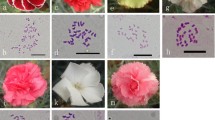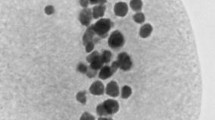Abstract
When dihaploids of EuropeanSolanum tuberosum are used as female parents in crosses with South American cultivated diploid potatoes (Group Phureja/Stenotomum), various kinds and degrees of male sterility are found in the offspring. The effect of using different dihaploid and cultivated diploid parents on shrivelled microspore sterility of F1 hybrid progenies was studied. Variation in the character was continuous and statistical analyses showed high general combining ability for dihaploid parents but not for cultivated diploids. A significant but non-linear relationship was found between percent of stainable pollen and seed set in crosses with female tester parents, provided that some degree of functional male fertility was present. F1 clones with pollen of normal appearance but with no functional fertility probably represent a hitherto unclassified cytoplasmic male sterility. The results are discussed from the point of view of methods to be adopted in improving potatoes at the diploid level.
Similar content being viewed by others
References
Ariyasu, T. (1959). Density effect of pollen put on artificial culture media upon its germination and pollen tube growth.Bot. Mag. (Tokyo)72: 475–476.
Chase, S. S. (1963). Analytic breeding inSolanum tuberosum L.—A scheme utilizing parthenotes and other diploid stocks.Can. J. Genet. Cytol. 5: 359–363.
Comstock, R. E. & M. F. Robinson (1952). Estimation of degree of dominance of genes. In: “Heterosis”, Ed. Gowan; Iowa State College Press, pp. 494–516.
De la Puente, F. &S. J. Peloquin (1968). Male fertility of selected 24 chromosomeS. tuberosum hybrids.Am. Potato J. 45: 436–437.
Duvick, D. N. (1959). The use of cytoplasmic male sterility in seed production.Econ. Bot. 13: 167–195.
Fineman, Z. M. (1947). Elimination and retention of pollen sterility in potato improvement.J. agric. Res. 75: 135–145.
Grun, P. (1970b). Changes of cytoplasmic factors during the evolution of the cultivated potato.Evolution Lancaster Pa.24: 188–198.
Grun, P. (1970b). Cytoplasmic sterilities that separate the cultivated potato from its putative diploid ancestors.Evolution Lancaster Pa.24: 750–758.
Grun, P. &M. Aubertin (1965). Evolutionary pathways of cytoplasmic male sterility inSolanum.Genetics 51: 399–409.
Grun, P. &M. Aubertin (1966). Cytological expressions of a cytoplasmic male sterility in Solanum.Am. J. Bot. 53: 295–301.
Grun, P., M. Aubertin &A. Radlow (1962). Multiple differentiation of plasmons of diploid species ofSolanum.Genetics 47: 1321–1333.
Hougas, R. W. &S. J. Peloquin (1958). The potential of potato haploids in breeding and genetic research.Am. Potato J. 35: 701–707.
Hougas, R. W. &S. J. Peloquin (1960). Crossability ofSolanum tuberosum haploids with diploidSolanum species.Eur. Potato J. 3: 325–330.
Hougas, R. W. & S. J. Peloquin (1961). Genetics and cytogenetics of the tuber bearingSolanum species. “The National Potato-Breeding Program, 1961”. Publ. U.S.D.A. pp. 208–209.
Howard, H. W. (1970). Genetics of the potato. Logos Press Ltd., London, p. 22.
Liberal, M. T. (1966). Fertilidade de populaçoes em F1 e F2, envolvendo haploides deSolanum tuberosum L. e diversas especies diploides.Pesq. agropec. bras. 1: 165–172.
Parker, P. F. &M. Borrill (1968). Studies inDactylis I. Fertility relationships in some diploid subspecies.New Phytol. 67: 649–662.
Peloquin, S. J. &R. W. Hougas (1960). Genetic variation among haploids of the common potato.Am. Potato J. 37: 289–297.
Perez Ugalde, G., R. W. Hougas &S. J. Peloquin (1964). Fertility ofS. phureja—haploidS. tuberosum F2 hybrids.Am. Potato J. 41: 256–262.
Ross, R. W., S. J. Peloquin &R. W. Hougas (1964). Fertility of hybrids fromSolanum phureja and haploidS. tuberosum matings.Eur. Potato J. 7: 81–89.
Salaman, R. N. &J. W. Lesley (1922). Genetic studies in potatoes; sterility.J. agric. Sci. 12: 31–39.
Simmonds, N. W. (1971).50th Rep. Scott. Pl. Breed. Stn.: 16.
Sosa, R. &M. Hernandez De Sosa (1972). Use of dihaploids in the breeding ofSolanum tuberosum L. II. Crossability behaviour.Hereditas 70: 135–152.
Suchtelen, N. J. van (1966). Investigation of dihaploid potatoes in the Netherlands.Eur. Potato J. 9: 64–68.
Author information
Authors and Affiliations
Rights and permissions
About this article
Cite this article
Carroll, C.P. The inheritance and expression of sterility in hybrids of dihaploid and cultivated diploid potatoes. Genetica 45, 149–162 (1975). https://doi.org/10.1007/BF01517192
Received:
Accepted:
Issue Date:
DOI: https://doi.org/10.1007/BF01517192




